
As we have seen in previous Features from the field posts, structural fabrics are both informative and spectacular. But many structural geologists will list a shear zone fabric, such as mylonite, as their favourite!
As Samuele, Hannah and I wrote in a previous post, shear zones are regions of intense deformation where rocks have accommodated an extremely high amount of strain and that strain has been strongly partitioned into narrow zones. Outside the shear zone the rocks are relatively undeformed.
In that first post in this series, we introduced mylonitic fabrics to you. In this post, let’s talk about composite fabrics which can also be important and informative in many deformed rocks.
So what is a composite fabric?
A composite fabric is a structure where two (or more) new foliations form at low angles to one another during the same deformation event. The sheared rock has a distinctive fabric defined by these two foliations.
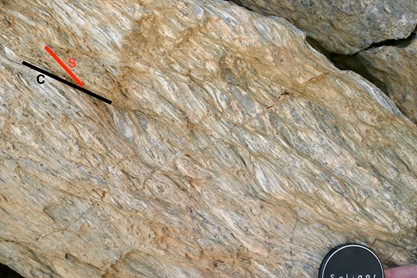
S-C fabric in Neoproterozoic phyllonitic metasediment of the Adelaide Fold Belt, South Australia. Deformation during the Palaeozoic (c. 500 Ma) during the Delamerian Orogen is likely responsible for formation of the composite fabric at this locality. Shear sense is right to left (source: Sandra McLaren)
Most commonly the two foliations are the S-fabric and the C-fabric. The S-fabric (where S is from the French word schistosité) is the penetrative fabric, defined by alignment of deformed minerals within the sheared rock. The C-fabric (from the French cisaillement meaning shear) consists of the spaced surfaces along which shear movement has been concentrated.
The geometry of these fabrics can be a bit confusing so let’s look a bit more closely to understand how to identify and interpret them, and to get an idea of how they form.

Cartoon to show the components of a composite fabric and how they form. Note that the S-fabric forms due to the realignment and change in shape of minerals within the rock as a result of ductile deformation processes such as crystal-plasticity. The C-fabric forms as a spaced fabric as mini-shear zones accommodate strain (source: Sandra McLaren)
The S-fabric forms as components of the rock are rotated into the direction of shear. Individual minerals will show shape change (strain) that has happened by a process such as crystal-plasticity. The minerals will become ellipsoidal in shape reflecting the direction of the shearing. This is often most commonly observed in quartz but also occurs in other minerals depending on the temperature at which shearing occurs. In the Cape Conran examples in the photos below, K-feldspar is showing this behaviour.

Detail of composite planar (S-C) fabric within the Cape Conran Granite (Victoria, Australia). Note the ‘tails’, formed as a result of crystal-plastic processes during shearing, at the corners of the large K-feldspar porphyroclasts
(credit: Sandra McLaren)
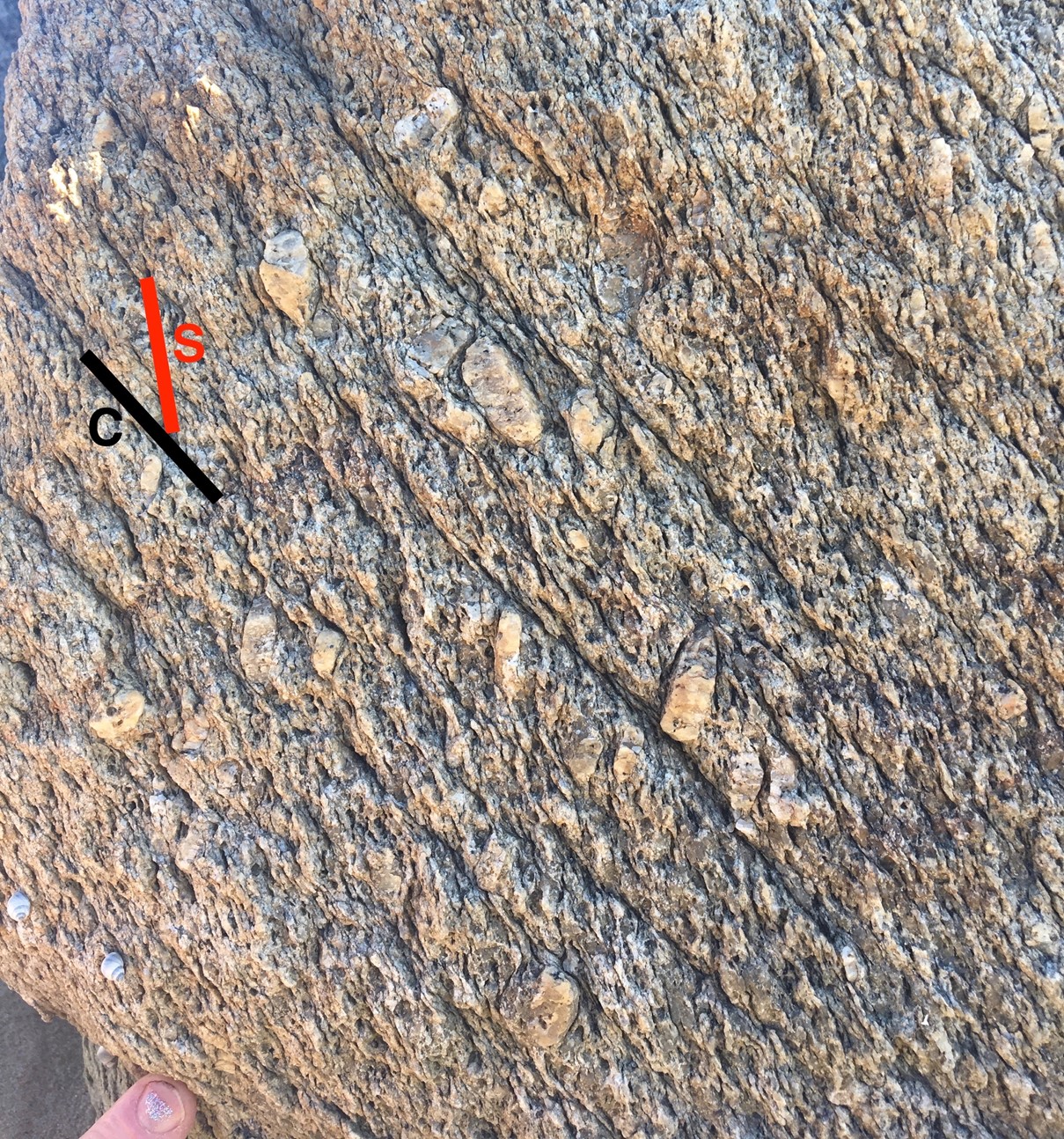
Composite planar (S-C) fabric within the Cape Conran Granite (Victoria, Australia). Sense of movement is top to the left (West over East) during shearing at around 380 Ma (credit: Sandra McLaren)
The C-fabric forms as a set of mini shear zones, characterised by marked grain size reduction. These will be parallel to the maximum strain axis (X) so the C-fabric will be parallel to the shear zone boundary. The orientation of the C-fabric helps us to identify the dip and strike of the shear zone and its sense of movement.
The angle between the S-fabric and the C-fabric varies but can be a reliable shear sense indicator if it’s consistent.
With increasing total strain, the C-fabric and S-fabric rotate to eventually become parallel or near parallel to each other. Where this has happened we no longer have individual S and C fabrics but a combined fabric that can be called CS.
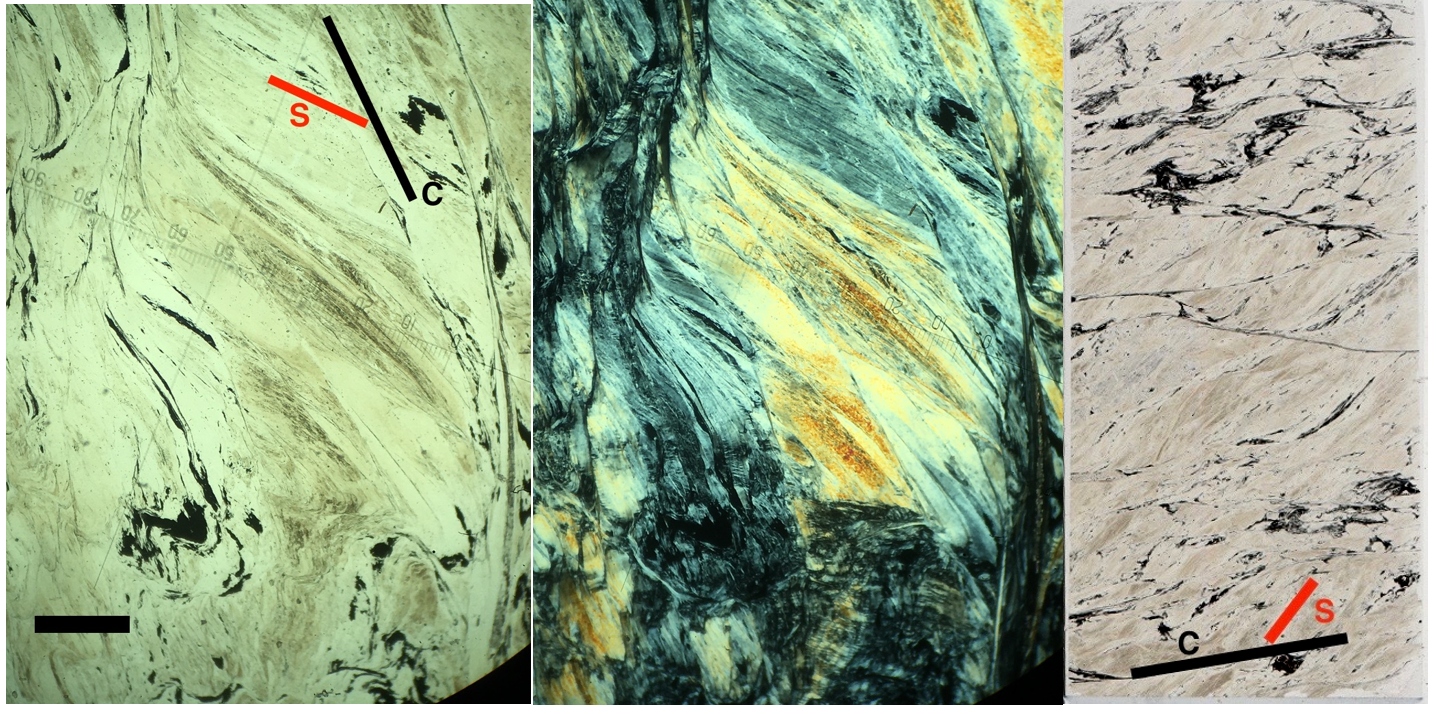
Composite planar (S-C) fabric within serpentinite from an unknown location. Left image = PPL, Centre image = XPL, black scale bar is 80 microns. Right image = whole of thin section in PPL. Length of long side of thin section = 50 mm (credit: Sandra McLaren)
References and Further reading
Lister, G.S., Snoke, A.W., 1984, S-C Mylonites, Journal of Structural Geology, v. 6, p. 617-638, https://doi.org/10.1016/0191-8141(84)90001-4
TS Must-Read – Lister and Snoke (1984) S-C Mylonites
Fossen, 2010, Structural Geology. Cambridge University Press.
Davis, George H. Structural Geology of Rocks and Regions. Wiley Global Education US, 2011. [VitalSource Bookshelf]


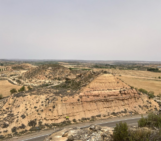
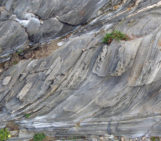
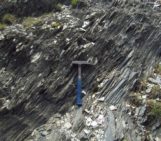
Anatol
This information is usefull for me because I never was in field with such geology…
Jur Snijder
An excellent summary, thank you for this. I was recently in Brittany on a field trip led by Prof. Philippe Boulvais from Rennes University. Here we saw C-S fabrics both at mm. outcrop scale (in a granite quarry) and at the km. map scale – the geological map of Brittany shows how granite bodies emplaced along the (dextral) shear zones of the South Armorican Shear Zone have the same typical teardrop shape as the feldspar crystals in the hand specimens. Geology is fractal!
Katie
This is the best explanation of this that I have seen. Thanks so much.